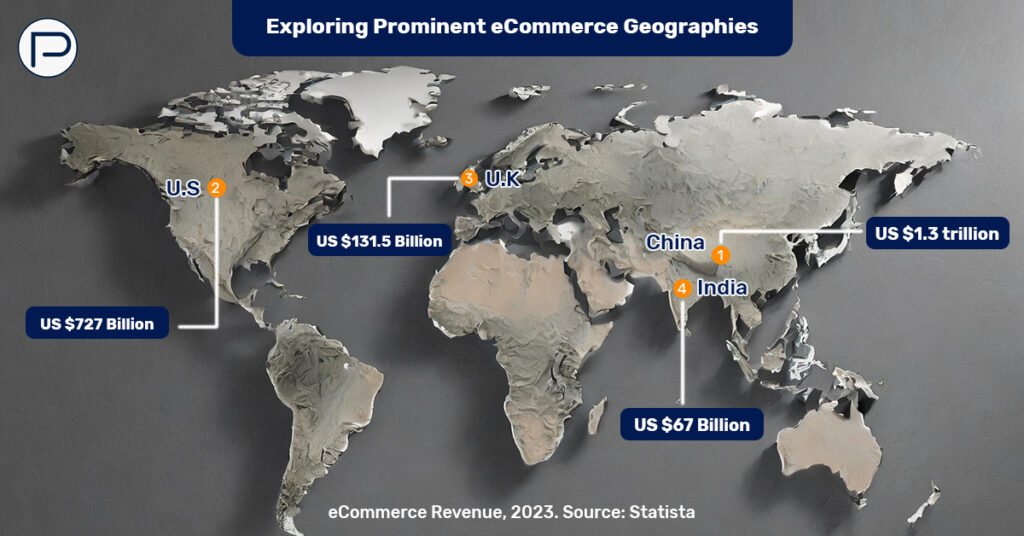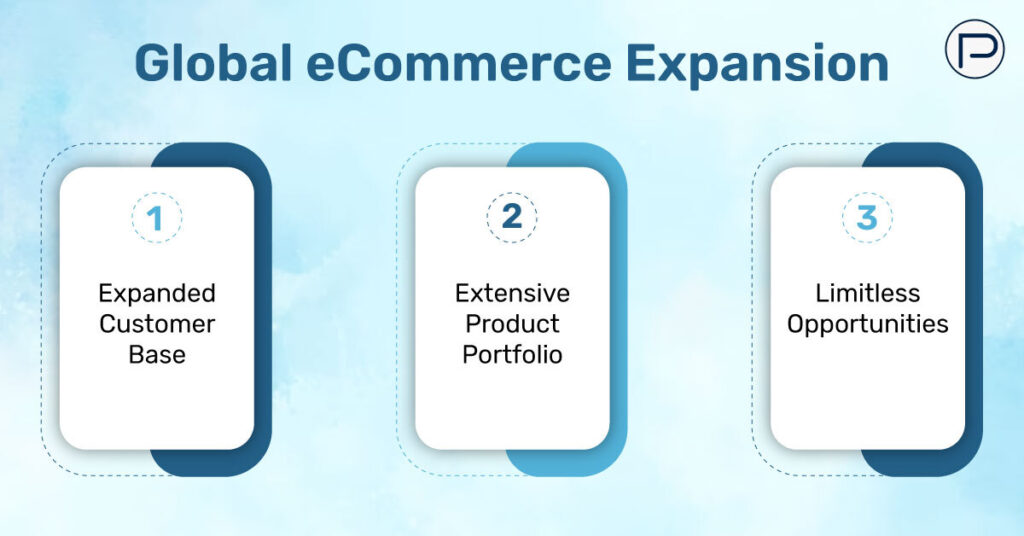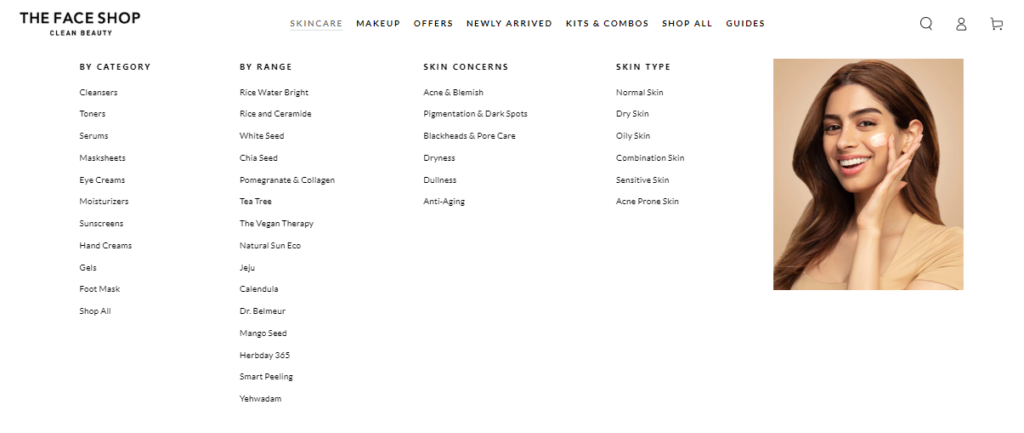The world has become intertwined due to all the technological advancements. So are the businesses; to expand, one must adapt to the changes and pursue them online.

The blog focuses on a framework for setting foot in global eCommerce. Dive in to get a hang of the ongoing trends and strategies needed to execute your business on a global scale.
Global eCommerce

Selling products and services online across geographies to customers in different countries is the renowned definition of global eCommerce. Tapping into new territories sounds enthralling, as technology has made it easier for brands to promote their products globally through online marketplaces.
Statista revealed, “By 2028, the number of users is expected to touch 4.5 billion in the eCommerce market.” Moreover, user penetration will be 53.9% in 2024 and will hit 63.2% by 2028.
A wide range of industries are submerged in this eCommerce market/industry. Its rise enables businesses to improve their customer base, and revenue, along with introducing new products and services to ease their customers’ lives.
JP Morgan’s report on global eCommerce trends states, “Digital technology continues to transform the way producers, suppliers, and consumers around the world connect and transact with one another.” Hence, specific data-driven insights are essential for the brand to kick-start business in other countries.
Amazon (B2C) and Alibaba (B2B) are widely renowned platforms with a global presence worldwide. Why is expanding globally important? What does it bring to the table or what are the requirements for global expansion? Is global expansion worth the hype? And how can you begin with global expansion? I will unfold the answers to these questions in the upcoming sections of the blog. Stay tuned!
But before we dive any further into its importance and challenges, let’s take a look at prominent eCommerce markets around the globe.
Table of Contents
Exploring Prominent eCommerce Geographies & Categories

- China
- Leader in the eCommerce industry worldwide, with US $1.3 trillion in revenue in 2023. The market is expected to touch US$3.56 trillion by 2024. Alibaba, JD.com, and Pinduoduo dominate the Chinese eCommerce market. Electronics come in second with 11.2% of the market share, after fashion, which accounts for 35.1%.
- United States
With a revenue of US$727 billion, the USA is the second-largest eCommerce market in the world. Amazon, Walmart, and eBay are prominent eCommerce platforms in the USA, dominating a significant share of the market.
The top categories involve Electronics and Gadgets, Fashion & Apparel, and Home & Kitchen products.
- United Kingdom
The eCommerce market in the United Kingdom is growing significantly year over year. The UK eCommerce market is projected to grow at a rate of 7.7% in 2024, which will contribute to the global growth rate of 10.4% (eCommerce DB).
Amazon UK, ASOS and Tesco are dominant eCommerce players in the United Kingdom.
Fashion tops the eCommerce revenue list with 28.4%, while Hobby & Leisure accounted for 15.6% followed by Electronics accounting for 16.5% in 2023.
- India
India is one of the fastest-growing eCommerce markets in the world, with an estimated revenue of US$104,931 in 2024. Top categories include Electronics which account for 23.7% of the Indian eCommerce market, followed by Hobby & Leisure (20.8%) and Fashion (18.7%).
Flipkart, Amazon, Myntra, Ajio, Nykaa and Meesho are the renowned eCommerce marketplaces in the Indian market. Furthermore, India’s global eCommerce sales are expected to boom over the coming years (eCommerce DB).
Global eCommerce Expansion: Why Is It Important?

Without a doubt, international expansion is a splendid opportunity for the brand’s growth. As per Statista, the Global eCommerce Market is expected to surpass $6 trillion by 2024.
The expansion brings huge benefits, starting with an expanded customer base, a diversified presence, an extensive product portfolio and much more.
1. Expanded Customer Base

Diversified markets lead exponentially to an increased customer base, which in turn helps the brand understand the customers’ preferences better and generate sales. A huge customer base brings stability to the business.
Setting up operations in foreign markets aids the brand’s online and offline presence. One such example is The Face Shop, a premium cosmetic brand hailing from South Korea that is a well-known player in the beauty industry with a global presence both online and offline on a global scale.
2. Extensive Product Portfolio

When going global, a strong product portfolio is a must. With the acquired data insights on customers’ preferences, you can work on a new product line and launch it in the country; it can be limited to a specific region or unveiled in the countries where you offer products and services in.
An extensive portfolio fetches competitive advantages such as potential suppliers, cost-efficiency, and access to modern technology and resources that will help you work on high-quality products at an effective price.
3. Limitless Opportunities

As a global brand, whether small or large, you’ll have access to a huge pool of resources. Expansion will strengthen your brand’s position in the market and help you gain more credibility among others.
Once you set foot in a new territory adhering to international policies and guidelines, the expansion path will open up humongous opportunities worldwide due to the brand image and presence in the existing markets.
Global expansion sounds enthralling and garners a lot of benefits, but it comes with multiple restrictions as well. Moving on to the challenges a brand faces during global expansion and how you can conquer them.
Globalising Your E-commerce Business
Let’s dive into the best practices required for globalising your business in the eCommerce space. Measuring success in global eCommerce demands a tailored approach to analytics to enhance global presence.
- Key Performance Indicators
Key Performance Indicators are important, from monitoring sales revenue for overall performance evaluation to the Conversion Rate, which reflects the platform’s effectiveness in customer acquisition. Metrics like the Cart Abandonment rate track the percentage of abandoned carts and obstacles a customer might experience during checkout.
- Leveraging Data to Optimise Global eCommerce Presence
Analyse data on local customer preferences, and cultural beliefs and tailor the product and its marketing techniques accordingly. Supposedly, you are working on launching a set of four antique cups. The set could do well in India but in Japan, the number 4 is considered a symbol of bad luck. Hence, segmenting beforehand becomes crucial.

On the other hand, customer feedback makes you better able to analyse the feedback from customers and helps you identify pain points, and expansion opportunities. Monitoring competitor strategies will allow you to stay ahead in the market.
You can rely on Paxcom to provide you with the essential data and analyse it on your behalf, along with our expert guidance and tailored techniques to help you expand both domestically and internationally.
Challenges and Obstacles: Global expansion

- Linguistic barriers
The first and foremost challenge a brand faces while experimenting with new territories is language. Not every country’s first language is English, so it becomes imperative for the brand to stick to the country’s native language and English can be used as a secondary language.
The issue can be solved by offering intricate information in the native language. Local language provides a better and enhanced understanding of the product description, review section, exchange, and return policies. These factors determine the brand’s sincerity towards its consumers and increase the chances of conversion. Payments can also annoy customers, so it is advisable to allow customers to pay in their local currencies without any surprise costs. Offering a static amount will lead to fewer cart abandonments. Thus, providing transparency in payments is to be carried out effectively.
- Logistics and Operations
Shipping and logistics are some of the bummers that companies have to deal with to ensure a smooth and balanced experience for their customers. The world is fast-paced and so are consumers’ expectations; shipping has to be quick without delays and they don’t like to pay dreadful amounts for shipping.
The USA waives shipping charges after a certain amount. Meanwhile, in India, consumers are spoiled with a 1-3-day delivery window and Amazon even offers same-day delivery in some cases. A fixed timeline is important and the brand must ensure that the product reaches the customer in top-notch condition within the given time frame. Both overpromising and under promising timelines can backfire and make the customer lose interest in your product.
To resolve these challenges, one can try to opt for dropshipping and international warehouses to boost delivery. Setting up a minimum order amount for free shipping also influences customers’ buying decisions.
- Custom Duties and Tariffs
Cross-border trading or selling comes with import duties. The taxes are imposed as per the product category, value, weight, and quantity. Customs are unpredictable; they may or may not be charged, depending on the scenario. In India, a maximum of 51% of import duties can be charged on the product value. However, this may not be the scenario in other countries. Customs clearance sometimes leads to delayed deliveries and additional costs for the buyers.
The challenge can be overcome by opting for shipping companies that offer hassle-free customs clearance services. On the other hand, it is important to go through the resources to get a hang of the rules and regulations of the countries you are trying to set up your presence in beforehand.
- Customer Service
Global eCommerce gives you access to new resources, talent pools, and a larger market. All this becomes possible when your customers are satisfied with your product and service.
Shipping, returns, exchanges, refunds, and solving customers’ queries via chatbots or calls have to be handled efficiently. Every country has its own return and exchange policies; some may offer a 15-day return window, while others offer a 7-day one or even a 30-day window. Flexible return, exchange, and refund policies encourage customers to try the product.
Currently, customer service also includes flexible payment options like Buy Now, Pay Later, Buy Online, Pay In Store (BOPIS), interest-free EMI options, or using different payment plans. Last but not least, chatbots are trendsetters in the industry. From resolving customers’ basic queries both pre and post-purchase to suggesting products as per trends, chatbots are capable of fulfilling them and influencing customers’ decision-making power.
Tap Global eCommerce With Paxcom
In conclusion, tapping into global eCommerce markets presents a lucrative opportunity for businesses to expand their reach and increase revenue streams. Leveraging the expertise of an eCommerce agency can be instrumental in navigating the complexities of international markets and achieving sustainable growth. Here’s how:
1. Strategic Guidance: Our experts offer specialized knowledge and experience in navigating diverse global markets. With our strategic guidance tailored according to the brand’s requirements, we help businesses identify opportunities and overcome challenges effectively.
2. Omnichannel Marketing: In today’s interconnected digital landscape, omnichannel marketing is essential for engaging customers across various touchpoints.
3. Digital Shelf Analytics: Understanding consumer behaviour and market dynamics is imperative for optimizing product visibility and sales performance. Leverage advanced digital shelf analytics tools, analyze market trends, monitor competitor strategies, and optimize product listings to maximize sales and profitability. Discover how we utilised our AI-powered digital shelf analytics tool to track active price variation across marketplaces.
4. Global Campaign Management: Managing marketing campaigns across multiple countries requires careful planning, coordination, and localization. An eCommerce agency can handle all aspects of campaign management, from strategic planning and content creation to execution and performance tracking, ensuring consistent messaging and maximum impact across diverse markets.
With emerging markets and mobile commerce driving significant growth, global markets are on the rise. Additionally, trends such as personalized shopping experiences, hybrid commerce, voice commerce, and sustainability shape consumer preferences in the global marketplace.
Partnering with an eCommerce agency equipped with expertise in global market dynamics, omnichannel marketing strategies, and data-driven insights is essential for businesses looking to capitalise on the immense opportunities offered by global eCommerce markets in 2024 and beyond.
Have a look at How Paxcom Helped A Health And Beauty Wellness Category Achieve A 71% Growth In Conversion?
Leverage the right resources and position yourself in this dynamic landscape; feel free to reach out to us at info@paxcom.net for more information.














